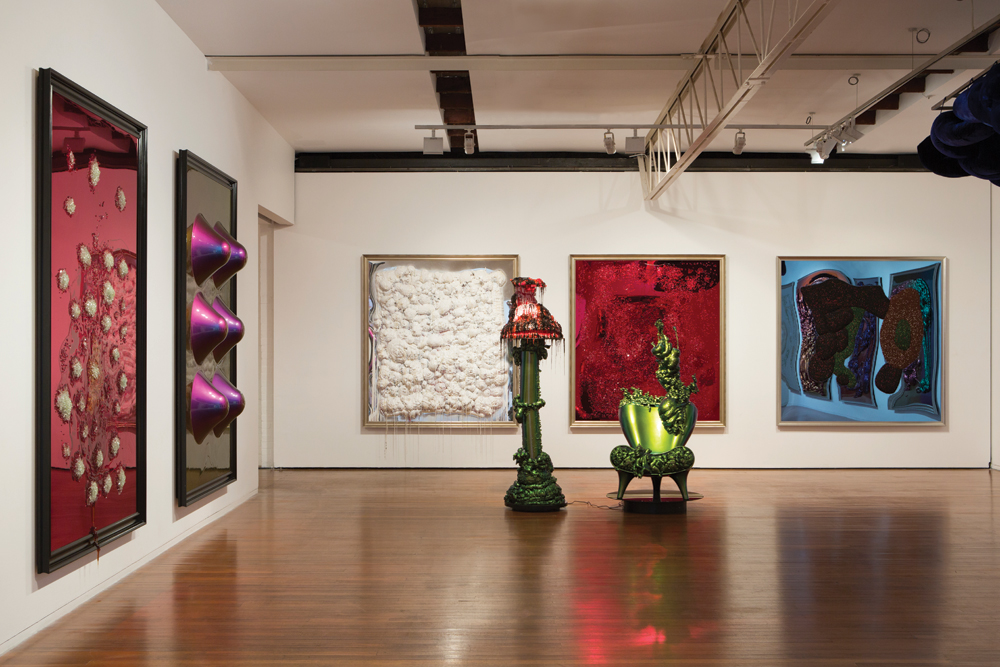Dale Frank
Roslyn Oxley9 Gallery, Sydney, Australia
Roslyn Oxley9 Gallery, Sydney, Australia

Looking at big, bold and alluring abstract paintings, it’s hard these days not to think of ‘zombie formalism’ – the kind of abstract art in which novelty is often mistaken for originality. In Dale Frank’s latest exhibition, ‘Sabco Peroxide,’ the 57-year-old wears the pejorative attributes of this kind of abstraction as a badge of honour. Regarded as one of Australia’s most acclaimed and polarizing contemporary artists, Frank has been combining painterly intensity with bad-boy provocations and art-market know-how since the late 1970s.
Although Frank has toyed with figurative painting and performance art throughout his career, he is an abstract painter at heart, one who regularly experiments with industrial materials and processes to create liquescent, visceral and idiosyncratic works. In this exhibition, his 26th at Sydney’s Roslyn Oxley9 Gallery, 19 exquisitely coloured paintings on Perspex dominate, utilizing materials such as varnish, automotive paint, construction foam and oil-based primers. Most of the works have dazzling, highly reflective surfaces that evoke the allure of funhouse mirrors, while their frames recall their household counterparts. This ‘domestic-meets-fairground’ sensibility is bolstered by three sculptural works that take Frank’s practice into the realm of furniture design, albeit with typical eccentricity.
In the two-by-two metre painting The Welsh (unless otherwise stated, all works 2015), an amorphous orange splotch on a pink mirrored background distorts the viewer’s reflection, whereas Angela Merkel offers subtler deformations through a monochrome of aqua-green varnish. Other large-scale paintings feature smooth-edged blobs made from granulated car tyres (Goyisher Head) and grotesque lines and lumps of pressurized construction foam spluttered onto opaque, metallic backgrounds (The Thirsty Fucker and Cheez Whiz), the latter of which could be described as ‘Lynchian’ in its schlocky yet otherworldly evocations.

More interesting are Staircase Talent and Chain Smoker; they comprise fragments of smashed car windscreens – from a BMW and a Lexus, apparently – on Perspex. At once paintings, mirrors and forensic objects, these pictures move away from Frank’s signature aqueous forms to give the impression that we are looking at, on and through them all at once. As in all of his output, here Frank makes use of titles that bear little relation to the works themselves. Less surreal than interchangeable, his titles are distancing devices that compel you to stop worrying about meaning and attune yourself simply to experiencing the actual works. Aside from a vague connection with the artist’s use of industrial materials and interest in domestic interiors, the title of the exhibition itself offers little in terms of a conceptual hook on which to hang your interpretations: ‘Sabco’ is the name of a large Australian company that sells cleaning products such as brooms, buckets and dusters.
Frank’s work is least resolved – and least sincere – when he strays from the medium of painting. He Collected Pearl Necklaces is essentially a vibrant blue velvet sofa (designed by Brazilian duo, the Campana Brothers), which has been suspended, dominatrix-style, from the gallery ceiling with a custom-made metal frame, chains and rubber straps. To Cry Like a Baby, Laugh Like a Girl similarly incorporates luxury furniture, this time Marc Newson’s Orgone Chair, which Frank has decorated and sabotaged with painted construction foam, filling its hollow interior and transforming it into a contemporary version of a gothic throne. While the exhibition is indicative of Frank’s exemplary intention not to grow old gracefully, its postmodern quip that art is just another boutique commodity ultimately dilutes his sobering attention to materials that, at its best, invokes all the pleasures and power of looking.























